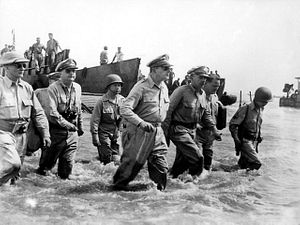Although of tremendous material consequence, the Battle of Leyte Gulf did not leave a lasting tactical or operational legacy. Some things became clear: The destruction of HIJMS Musashi confirmed that even the largest battleship could not survive concentrated carrier air power. Complex operations suffered from a lack of communications capabilities. The fog of war could intercede even in the context of otherwise good reconnaissance and communications technologies. But most of this was well understood before the battle began, and only confirmed impressions that naval analysts had already developed.
The kamikaze was the big exception to this. On the late morning of October 25, 1944, Japan launched the first organized suicide attacks against the aircraft carriers of Taffy 3, which had just survived an assault by the battleships and cruisers of Admiral Takeo Kurita’s Center Force. The attacks sank the escort carrier St. Lo, and damaged most of the others. These were not the first suicide attacks of the war, even in the Pacific, as pilots of damaged aircraft had often tried to inflict damage on their way out. Indeed, Germany developed similar units designed to ram American and British strategic bombers. However, they did represent the beginning of the most organized effort of any combatant to use suicide tactics for strategic effect. And just as important, they exposed a critical problem in how the USN thought about carrier operations.
As Jerry Hendrix points out, kamikazes were, in effect, long-range cruise missiles that had the potential to outdistance carrier air wings. Although the Japanese did not always take advantage of this aspect of the kamikaze, the lack of a need to return to base made carriers vulnerable from beyond their own lethal range. This realization had an important impact on how the U.S. Navy thought about developing aircraft and managing the carrier air wing as a whole. Similarly, the disinterest of kamikaze pilots in surviving their sorties prefigured the era of the anti-ship cruise missile. Study of kamikaze tactics also had a practical impact on the Navy’s thinking about cruise missile defense, both from fighters and from ships.
Although kamikazes could not turn the tide either at Leyte or in the war as a whole, they were clearly bad news for the Americans. Over the last 10 months of the war, kamikazes would wreak an awful toll on U.S. warships, sinking at least 47 vessels of various types and damaging many more. The fleet carriers USS Franklin and USS Bunker Hill were both nearly lost, and others (including the USS Enterprise) were severely damaged. The turn to kamikazes may also have had a political and strategic impact on the way the war ended. President Harry Truman certainly worried about the casualties that suicidal Japanese defense of the home islands could inflict, and the example of kamikazes colored his thinking. Of course, the strategic and political imperative to use the bomb probably would have existed in any case. In any case, the Japanese decision to turn to the kamikaze offered one of the most lasting, indelible memories of the death and destruction caused by World War II.
































